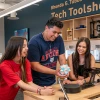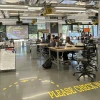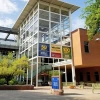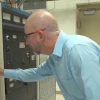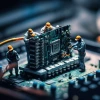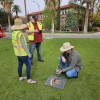Discovering University Library Technologies
A discovery series on the diversity and uniqueness of technology services at UArizona

(Pictured from left to right) Stacey Erdman - Associate Librarian, Digital Preservation Lead • Steven Chang - Department Head, TeSS • David Mayhew - Operations Manager (4 total staff) • Harriett Green - Vice Dean • Mike Hagedon - Development Lead (7 total staff) applications development, integration • Elia Nazarenko - Platforms Lead (5 total staff) enterprise app systems admin and integration
Today’s libraries at the University of Arizona are not what we might remember as recently as five years ago. The University of Arizona Libraries (UAL) are defined by their digital systems and collections, especially as an R1 academic research library system that has had explosive growth of digital services since the inception of the Student Success District.
Upon entering UAL’s Main Library, visitors are immediately immersed in a world of digital technologies. There are digital kiosks and tech-savvy support staff to help you research your needs online. To one side is the CATalyst Studios, where students, faculty and researchers are engaged with library staff for consulting on projects and to transform their learning content into interactive learning experiences of all formats (more on the CATalyst Studios in a future narrative).
What sets UAL apart is the seamless integration of library services with cutting edge technologies that the library technology staff develops and maintains. The close collaboration between UAL’s faculty and service professionals, and library technologists is visible everywhere.
Steven Chang, Technology Strategy & Services (TeSS) Department Head, sheds light on the intrinsic collaboration between his department and UAL’s faculty and staff. “The reason we work so closely with UAL faculty and staff is because these ‘non-technical’ staff are in fact quite technical. If you review the curricula from various graduate Library Science degree programs, you will see the convergence of Library Science with technical disciplines such as Management Information Systems (MIS) and Computer Science.” Among UAL’s faculty and staff, expertise can be found in database management, data modeling, data visualization, business informatics, programming, machine learning, artificial intelligence, and other areas of expertise.
Chang’s department is one of nine departments at UAL that each have very specific business operations requiring support by library technologists. The departments served by the TeSS portfolio of services include Access & Information Services, Collection Services, Health Sciences Library, Research Engagement, Special Collections, Student Learning & Engagement, The University of Arizona Press, and Library Administration.
TeSS staff develops, maintains, and provides support for enterprise applications critical to delivering library services. This includes the library management system (called Alma) and its companion frontend discovery system (called Primo) and a proxy system (EZProxy) which allows UA affiliates to access the library’s extensive collection of online research databases. TeSS also helps to maintain the InterLibrary Loan platform (called ILLiad). Similar tools are used at most higher education institutions and libraries across the globe.
One example of where TeSS staff are tightly embedded in library services is in the area of digital preservation. In the digital preservation process, UAL faculty and staff collaborate closely with technology professionals to ensure the safeguarding (stewardship), accessibility, and usability of information resources through advanced technological solutions. Chang’s TeSS team plays a critical role in support of preserving the library’s extensive collection of information resources. He explains that today's libraries collect far more than physical books. UAL’s collection contains a plethora of both analog and digital formats, which underlines the necessity of having specialized technology staff and infrastructure.
Before an information resource can be ‘digitally preserved,’ it must first be digitized (analog source) or otherwise processed (born digital source). UAL operates an audiovisual lab, a forensic lab, and a digital production lab to facilitate the digitization process. The TeSS operations group builds, maintains, and supports the specialized equipment and infrastructure necessary to capture every page of a high-value book or second of a recording, many of which are on fragile media.
The digitized and processed content are then ingested into the UAL’s Preservation Archive storage environment. TeSS developers and system administrators have crafted a specific adaptation of the Library of Congress' BagIt specification, facilitating UAL’s ability to archive materials in the Academic Preservation Trust (APTrust), a national digital preservation consortium of higher education institutions. In this process, TeSS and UAL faculty and staff work together to compile digital files and metadata into ‘bags’ for long-term high assurance preservation. These are then securely deposited and stored in APTrust's network, where they are replicated and regularly checked for integrity.
Finally, storing and maintaining this digitally preserved content requires an immense amount of on-site storage. Metadata that is created or extracted by UAL faculty and staff must be captured to be included for every digitized page of a high-value book, document, recording, or artifact. TeSS maintains a full operations center for on-site storage, networking, and compute. In addition, TeSS maintains a robust, multi-vendor cloud infrastructure. These on-site and cloud assets are leveraged heavily in digital preservation workflows. TeSS system administrators manage the approximately 150 terabytes of content selected for long term preservation (in various states) in primary storage. Double that for on-site secondary storage and add one to four cloud copies to guarantee that this content is preserved for future generations.
There is so much more of a story to tell about the symbiotic relationship between UAL and technology. Next up, the CATalyst Studios!


